Martha Doesn’t Say Sorry
 “There are many things Martha does, but apologizing isn’t one of them.” Sweet, present-making, snack-sharing, hug-giving Martha does many things, but some of the things she does aren’t so nice. During those difficult moments (like when Martha plays her drum kit next to her napping baby brother), Martha wants to make things right, but Martha Doesn’t Say Sorry. Her inability to make amends comes back to haunt her. Martha wants a cookie, but Martha’s mom doesn’t give cookies to people who don’t say sorry. Her father and baby brother don’t feel like accomodating people who don’t say sorry, either. In the end, Martha is finally able to say sorry, which comes in handy as she inevitably does something not so nice again (baby brother’s face as he looks at his first birthday cake with a big swipe missing gets me every time!)
“There are many things Martha does, but apologizing isn’t one of them.” Sweet, present-making, snack-sharing, hug-giving Martha does many things, but some of the things she does aren’t so nice. During those difficult moments (like when Martha plays her drum kit next to her napping baby brother), Martha wants to make things right, but Martha Doesn’t Say Sorry. Her inability to make amends comes back to haunt her. Martha wants a cookie, but Martha’s mom doesn’t give cookies to people who don’t say sorry. Her father and baby brother don’t feel like accomodating people who don’t say sorry, either. In the end, Martha is finally able to say sorry, which comes in handy as she inevitably does something not so nice again (baby brother’s face as he looks at his first birthday cake with a big swipe missing gets me every time!)
This book hits just the right note for talking with young ones about the importance of saying sorry. It’s not a finger-wagging didactic book – it’s funny, it’s relate-able, and I’m in love with the adorable art. We’ve all seen horrible books meant to teach children lessons that bore the socks off of kids and make the adult reader sound smarmy and smug. Read Martha Doesn’t Say Sorry by Samantha Berger and Bruce Whatley instead. You can remind your kids to do what Martha learned to do, when they are grabbing the book out of each other’s hands to read it again.
For more information, visit samanthaberger.com.
Read More“Press Here” for fun!
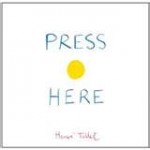 My dear friend’s daughter, Nora, turned one this month, and as a librarian, writer, and ardent-bordering-on-obsessive fan of children’s literature, I felt it my duty to include a book in her birthday bag o’ swag. Which book to choose? Press Here by Herve Tullet. Deceptively simple, it consists of dots and directions on what to do with them. Press the yellow dot and turn the page. Now there are two dots. Press the yellow dot again, and on the next page, now there are three dots. Tilt the book to the left, and on the next page, the dots seem to have slid to the left edge. Clap your hands to make the dots big, bigger, bigger. It is what electronic books wish they could be: it is interactive, delightful, and requires no batteries.
My dear friend’s daughter, Nora, turned one this month, and as a librarian, writer, and ardent-bordering-on-obsessive fan of children’s literature, I felt it my duty to include a book in her birthday bag o’ swag. Which book to choose? Press Here by Herve Tullet. Deceptively simple, it consists of dots and directions on what to do with them. Press the yellow dot and turn the page. Now there are two dots. Press the yellow dot again, and on the next page, now there are three dots. Tilt the book to the left, and on the next page, the dots seem to have slid to the left edge. Clap your hands to make the dots big, bigger, bigger. It is what electronic books wish they could be: it is interactive, delightful, and requires no batteries.
Considering that I had to pry Press Here from the hands of my 12- and 10-year-old children to put it in Nora’s gift bag, I can honestly say it’s not just for the littlest ones. My kids are no strangers to electronic games and they logically understand the way paper books work, but both of them followed all the instructions on the pages, like shaking the book to make the dots “move”. For toddlers, this book is magical. For kids who are building their reading skills, the simple text is engaging enough to read again, again, again. Press Here and see what happens!
Read MoreThe Question on Everyone’s Mind
 It’s August, and there’s one big question everyone has been asking: Is Your Buffalo Ready for Kindergarten? Thank goodness Audrey Vernick and Daniel Jennewein have made this fantastic book to help us find the answer. First of all, does your buffalo have a backpack? If so, your buffalo is good to go! Tell your buffalo not to worry about being the only one in class with horns and a hump – your buffalo can be proud of being the state animal for Oklahoma! And, as author Vernick reminds us, one of the things we learn in kindergarten is that everyone is special in his or her own way.
It’s August, and there’s one big question everyone has been asking: Is Your Buffalo Ready for Kindergarten? Thank goodness Audrey Vernick and Daniel Jennewein have made this fantastic book to help us find the answer. First of all, does your buffalo have a backpack? If so, your buffalo is good to go! Tell your buffalo not to worry about being the only one in class with horns and a hump – your buffalo can be proud of being the state animal for Oklahoma! And, as author Vernick reminds us, one of the things we learn in kindergarten is that everyone is special in his or her own way.
After you share this book with your students, find out what your state animal is, and make your own version of the book. Let students come up with what your animal needs to do or have in order to be successful in kindergarten. It’s a great way to soothe any fears about achieving this major milestone, for students and their parents as well!
Update: Audrey Vernick, extremely awesome person and the author of this book, let me know that there is a free downloadable teacher’s guide for Is Your Buffalo Ready for Kindergarten available on her website! Gotta love free! Go to audreyvernick.com to get it.
Read More
Retelling with file folder puppet theaters
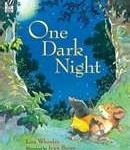 Kids retell stories all the time: they tell what they did over the weekend, what happened on the playground, who really put the building blocks in the fish tank, etc. Retelling is an important skill, and one fun way to retell a story is with puppets. I snagged this idea for making file folder puppet theaters off of this super-cool website: fairy dust teaching (Sally Haughey is one of those amazing teachers who has ideas I love to lift.) Cut windows in two file folders, attach them so you have a sturdy stand, decorate with scrapbooking paper, and ta da! Puppet theater! So now that folders are on sale for pennies a pack, I’m stocking up to make puppet theaters!
Kids retell stories all the time: they tell what they did over the weekend, what happened on the playground, who really put the building blocks in the fish tank, etc. Retelling is an important skill, and one fun way to retell a story is with puppets. I snagged this idea for making file folder puppet theaters off of this super-cool website: fairy dust teaching (Sally Haughey is one of those amazing teachers who has ideas I love to lift.) Cut windows in two file folders, attach them so you have a sturdy stand, decorate with scrapbooking paper, and ta da! Puppet theater! So now that folders are on sale for pennies a pack, I’m stocking up to make puppet theaters!
Puppet retellings work best with stories that have a limited number of characters and a straight-forward plot. One Dark Night by Lisa Wheeler and Ivan Bates is perfect for puppet theaters. One dark night, Mole and Mouse creep from their wee tiny house on a journey through the mush-mucky swamp, under sharp thistle thorns, into the marsh-misty wood. Meanwhile, a big giant bear in his big giant lair is feeling hungry. He leaves his den in search of food and finds Mole and Mouse. “Mole shivered. Mouse shook. Their fur stood up straight.” (Your listeners will be on the edge of their seats right about now.) The big giant bear towers over the wee beasts and grumbles, “You’re late!” Bear has been waiting for his two friends, who join him for a feast in his den.
Kids can make Mole, Mouse, and Bear puppets out of paper and popsicle sticks, and retell the story in their own table-top puppet theater! Or, if you’re lucky enough to have fantastic stuffed-animal-type puppets, put Mole, Mouse, and Bear, along with the book inside your Storybox and let the kids practice retelling that way, too.
Read MoreBeat the Heat with Blackout
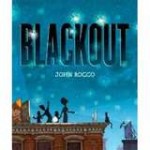 One hot summer night, a little girl looks for someone to play with her. Everyone is too busy – Dad’s cooking, Mom’s on the computer, Sister’s on the phone – when suddenly, the power goes out. In the blackout, the city changes. The family goes up the rooftop to look at the stars, and goes down to the street to join their neighbors in an impromptu block party. When the power comes back on, instead of going back to screen-filled, distracted normal, the family chooses to play a board game by candlelight, because “not everyone likes normal”.
One hot summer night, a little girl looks for someone to play with her. Everyone is too busy – Dad’s cooking, Mom’s on the computer, Sister’s on the phone – when suddenly, the power goes out. In the blackout, the city changes. The family goes up the rooftop to look at the stars, and goes down to the street to join their neighbors in an impromptu block party. When the power comes back on, instead of going back to screen-filled, distracted normal, the family chooses to play a board game by candlelight, because “not everyone likes normal”.
Brainstorm with students about what uses electricity and what we can do without electricity. Talk about how people lived (and still live) without electricity. If you have large enough windows in your classroom for natural light, try “unplugging” for an hour or two. Bring in flashlights for shadow puppets and for reading – because (gasp!) paper books don’t use electricity! Encourage families to try an unplugged night at home and let students share their experiences.
With its large, comic-book-inspired layout and few words per page, young readers will find John Rocco’s Blackout approachable – by fluorescent light, flashlight, candlelight, or sunlight.
Read MoreBubble Trouble
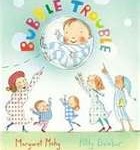 “Little Mabel blew a bubble, and it caused a lot of trouble…
“Little Mabel blew a bubble, and it caused a lot of trouble…
such a lot of bubble trouble in a bibble-bobble way.
For it broke away from Mabel as it bobbed across the table,
where it bobbled over Baby, and it wafted him away.”
I double-dog dare you to pick up Bubble Trouble (written by Margaret Mahy and illustrated by Polly Dunbar) and not read this tongue-twisting treat aloud. If you are an educator, we can babble and gabble about phonological awareness, the power of interesting rhyme to help young listeners hear the distinct sounds in words and therefore be better able to decode those words on a page, but frankly, the most important reason you could ever have to share this book with a listener of any age is simply for the pleasure of the patter.
After you and your kids have giggled and goggled until your brains are boggled (oh Margaret Mahy, I love you so), it’s the perfect lead-in to a science experiment with bubbles. There are a variety of homemade bubble solutions – most with dish soap, some with glycerin, some with corn syrup – and how fun would it be to test different solutions, or to vary the amount of one of the components to see how the bubbles are affected? What happens if you blow harder or softer? What if you blow through a square-shaped hole – could you make square bubbles?
If you can get your hands on Mercer Mayer’s wordless book Bubble Bubble, you’d have two fun, distinctly different books about bubbles to compare and contrast.
(For those of you who may be fretful and upset-ful about the baby in the bubble, fear not: thanks to pink and purple patchwork, the rebel treble Abel, and a well-aimed pebble, the baby boy rebounded to his mother’s safe embrace.)
Read More
Perfectly (Im)Perfect Square
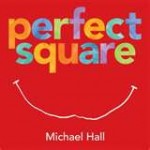 I fell in love with Perfect Square by Michael Hall when I first saw its vibrant, popsicle-colored pages. A square, with its four equal sides and four sharp corners, is perfectly happy, until it is cut into pieces and poked full of holes one Monday. But rather than groan about being ruined, the square takes its pieces and “made itself into a fountain that babbled and giggled and clapped.” On Tuesday, the square is torn to pieces that rearrange to make the flowers in a garden. Each day of the week, the square (painted in great swaths of colors that remind me of Eric Carle) is transformed, and the end of the story has a satisfying resolution that involves all the previous forms.
I fell in love with Perfect Square by Michael Hall when I first saw its vibrant, popsicle-colored pages. A square, with its four equal sides and four sharp corners, is perfectly happy, until it is cut into pieces and poked full of holes one Monday. But rather than groan about being ruined, the square takes its pieces and “made itself into a fountain that babbled and giggled and clapped.” On Tuesday, the square is torn to pieces that rearrange to make the flowers in a garden. Each day of the week, the square (painted in great swaths of colors that remind me of Eric Carle) is transformed, and the end of the story has a satisfying resolution that involves all the previous forms.
In preparation for my upcoming seminars, I’ve been spending a great deal of time studying the Common Core State Standards for kindergarten (if you, too, like spending evenings reading wordy documents about educational standards and benchmarks, check out corestandards.org) How do we teach the required standards and still include the books we love? Like this:
Share Perfect Square with your students. Read it first simply to enjoy a marvelous book. Read it again to the group and ask them about the wonderful vocabulary, “On Thursday, the square was shattered. What do you think shattered means? Let’s look at the picture.” Now we’re working on craft and structure, answering questions about unknown words. Take a picture walk through the book and have students explain what is happening. Now we’re integrating knowledge and ideas, hitting the kindergarten reading standard of linking the illustrations to the plot described in the words. Give students a square of colorful paper as an art extension activity to transform into something else. They’ll want to return to the book to see what author/illustrator Michael Hall did. Now we are actively engaging in group reading activities with purpose and understanding!
One cool story, three Common Core State Standards – all in a Perfect Square!
Read More






